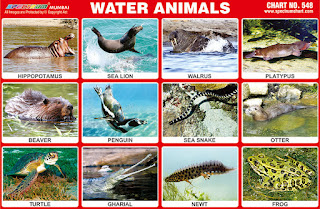Hippopotamus -
Hippopotamuses have short legs, a
huge mouth and a body shaped like a barrel. Hippopotamuses spend a
large amount of time in water such as rivers, lakes and swamps. They
are herbivores. They like to eat grass, fallen fruit, sugar cane and
corn. Hippopotamus typically lives
for around 45 years.
Sea Lion - Sea lions are
sea mammals characterised by external ear flaps, long foreflippers,
the ability to walk on all fours and short, thick hair. Sea Lions
are highly intelligent animals. They are often a popular attraction
at zoos and parks, where the sea lions are generally being trained
to do tricks with hoops and balls.
Walrus - A walrus is a
marine mammal, the only species of the family Odobenidae. They live
in the cold northern seas around North America & Europe. The
most famous thing about walruses are their tusks. Even though they
are called tusks, they are actually teeth growing out of their
mouth. Walruses can change colour depending on how warm they are.
They are usually different kinds of brown, but as they get warmer,
their skin can turn pink.
Platypus - Platypus is one
of the strangest mammals that look like a weird combination of duck,
beaver and otter. This animal can be found in the Eastern Australia
and Tasmania. Platypus lives near and in the freshwater lakes and
streams. Platypus has rubbery bill, webbed feet, long, flat tail and
fur.
Beaver - Beaver is one of
the largest rodents in the world. They spend part of their life in
the water and part on the ground. Waterproof fur prevents beavers
from freezing in the water; their webbed feet serve as fins and flat
tail as paddle, which all together provides efficient moving through
the water. Beavers are herbivores animals.
Penguin - Penguins are
sea-birds in the family Spheniscidae. All penguins have a white
belly and a dark (mostly black) back. Penguins cannot fly, but they
can swim very well. Penguins live only in the Southern Hemisphere of
the world: Antarctica, New Zealand, southern Australia, South Africa
and South America.
Sea Sanke - Sea snakes can
be found in the Indian and Pacific Ocean. There are around 60
species of sea snakes that differ in size, colour, type of diet and
habitat. Sea snakes are carnivores. Their diet mainly consists of
fish, crustaceans, mollusks and eggs of various sea creatures. Venom
of sea snakes is very strong. They use it to kill their prey and to
protect themselves.
Otter - Otter is a marine
mammal native to the coasts of the northern and eastern North
Pacific Ocean. Adult sea otters typically weigh between 14 and 45
kg. Otters have about 26,000 to 165,000 hairs per square centimetres
of skin. They have a rich fur for which humans hunted them almost to
extinction.
Turtle - Turtles are
reptiles having a hard shell that protects them like a shield, this
upper shell is called a ‘carapace’. Many turtle species can hide
their heads inside their shells when attacked by predators. Turtles
spend large amounts of their lives underwater.
Gharial – Gharial also
known as Gavial are found in the fast-flowing rivers in the northern
parts of the Indian subcontinent. Gharial has elongated, narrow
snout filled with 106 to 110 very sharp teeth. Gharial is a
carnivore, they hunt and eat fish. Gharials are listed as critically
endangered species.
Newt – A newt is a
semi-aquatic amphibian of the family Salamandridae. They can be found
in North America, Europe and Asia. Adult newts have lizard-like
bodies and may be either fully aquatic, living permanently in the
water or semi-aquatic, living terrestrially, but returning to the
water every year to breed.
Frog - Frogs are a diverse
and largely carnivorous group of short-bodied, tailless amphibians
composing the order Anura. Frog have long hind legs, elongated ankle
bones, webbed toes, no claws, large eyes and a smooth or warty skin.
Like other amphibians, oxygen can pass through their highly
permeable skins.


No comments:
Post a Comment